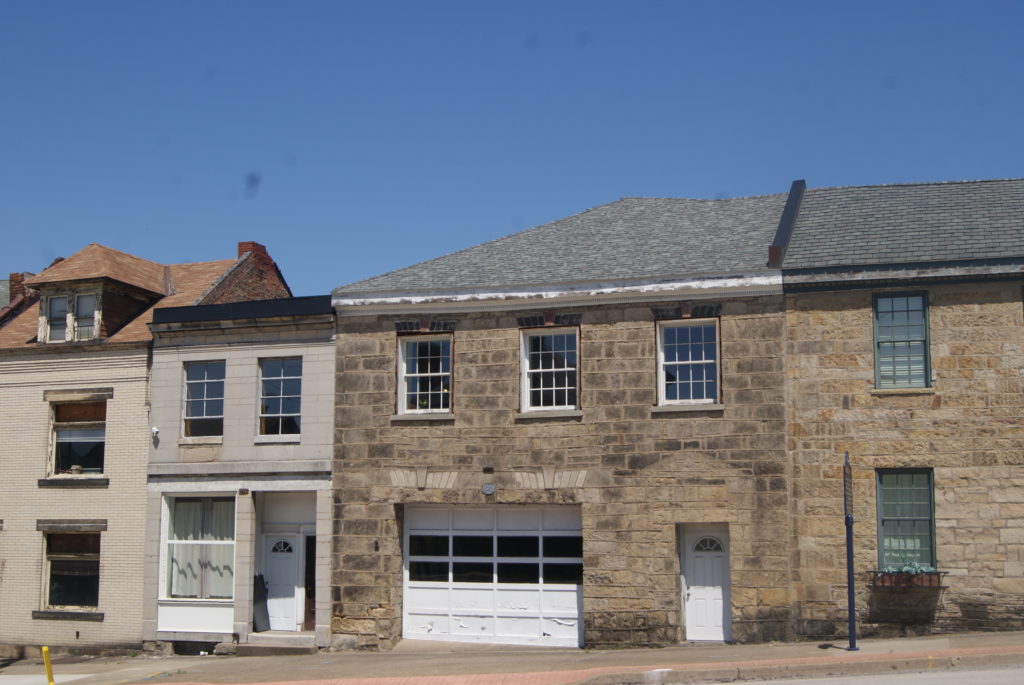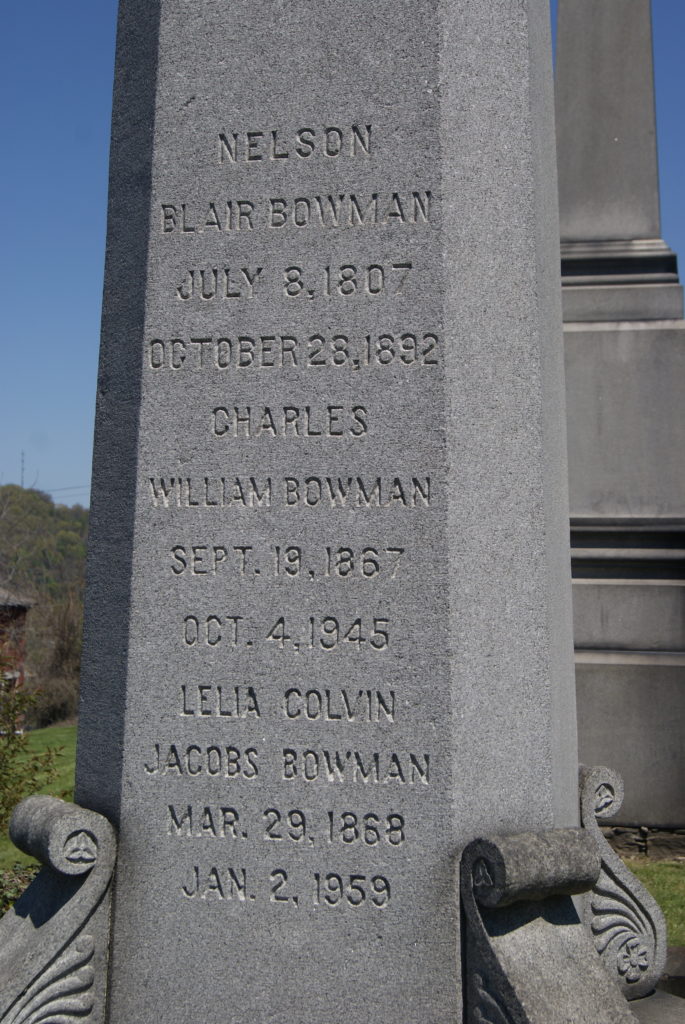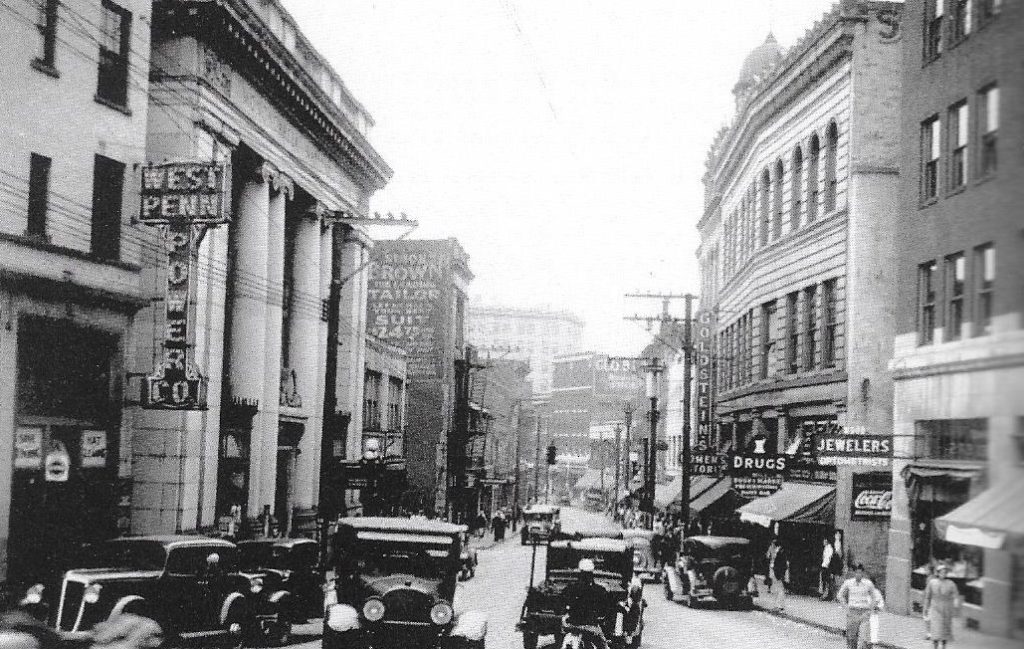Three imposing bank buildings within two blocks, all of them shuttered and deteriorating. Whole blocks of boarded-up storefronts. Lots covered by the rubble of torn-down buildings. These sights first greeted us when we drove into Brownsville, our next stop on our tour of the National Road. We’ve seen many down-at-the-heels Pennsylvania towns on our drives, but Brownsville makes Uniontown look like Paris. The decay was truly shocking. Yet, signs of life appeared, too, and we found much that was worth seeing.
A Little Brownsville History
Indigenous people occupied he site of Brownsville for at least a thousand years before Europeans came. The indigenes had built earthwork mounds along the Monongahela, which the early European settlers called Redstone Old Fort. During the French and Indian War, a European fort, Fort Burd, stood on the site.
White settlers arrived in the area around 1785. An early settler, Jacob Bowman, built a trading post on the bluffs above the river, with his family’s home on the second floor. Back then, the town was still called Redstone. Jacob his wife had nine children. His heir, Nelson, and his wife had six children, but only two survived to adulthood. Nelson died in 1892 and left the house to his son Charles, who lived there with his wife well into the twentieth century. The Bowman family added on to the building several times over the course of the nineteenth century, and it earned the name Nemacolin Castle. It still stands today, with tours available by appointment.
The town in the shadow of the Castle thrived in the nineteenth century. Brownsville became a gateway destination for emigrants heading west by river, a transportation hub and a center of boat-building. Small industries related to steel-making grew up later in the century.
Like so many small industrial towns in our state, Brownsville declined in the late twentieth century. But lots of historical sites remain, some of them very well-preserved.
Brownsville’s Historic Buildings
We stopped first at the Flatiron Building, which houses an art museum and a local history museum. Both are closed until further notice. But a peek through the windows and this review made us want to return when the museums are open. The building itself dates to 1835 and is owned by the Brownsville Area Revitalization Corporation.
A walk toward the creek below town puts you on the Dunlaps Creek Bridge, the first cast-iron metal arch bridge in the United States, dedicated on July 4, 1839.
The building that housed the Black Horse tavern still stands on Front Street, next door to the Castle, although it has been modernized and expanded. The Black Horse was the site of the first public act of the Whiskey Rebellion, on July 27, 1791. Here, David Bradford and the other Whiskey rebels intercepted mail from Philadelphia to Pittsburgh, looking for evidence that civic leaders in both cities sought to put down the rebellion.
The Shreve House also still stands, at the corner of Front and Third Streets. Henry Shreve was a prominent local businessman, steamboat captain, boat-builder and inventor. Shreve is most famous for the 1814 construction of the steamboat Enterprise, which he also captained to New Orleans to deliver munitions to Andrew Jackson during the War of 1812. The city of Shreveport, LA, is named for him.
The Brashear tavern and house at 519 Market Street, was built around 1796 by Basil Brashear. Lafayette addressed Brownsville citizens from the tavern door when he visited that same year. Basil Brashear’s grandson, John A. Brashear, was born in Brownsville and became a well-known Pittsburgh astronomer, inventor and educator.
Brownsville’s Historic Churches
Two historic churches also grace the town of Brownsville. St. Peter’s, at 188 Church St., is a Gothic revival building constructed in 1845. It houses the oldest continuously operating Catholic parish in Western Pennsylvania, and is believed to be the location of the first Christian services offered west of the Allegheny Mountains.
Christ Protestant Episcopal Church stands on the corner of Church and Fourth Streets. First organized in 1785 and served by missionaries, the first church building was erected in 1823. The current building dates to 1856. Thomas Brown, the founder of Brownsville, is buried near the church door. In the graveyard behind the church, you can also visit the graves of the whole Bowman family. They’re hard to miss; very large obelisks mark them.
A Really Good Lunch – and a surprise bonus
When we do these drives, Al and I like to find a non-chain local restaurant for lunch. We found a great one on this drive: Paci’s in West Brownsville. They serve pub grub, but really, really good pub grub. The French fries were very crisp and not greasy. Al’s steak sandwich contained a real slab of steak, not chipped steak. And – bonus! – the restaurant building formerly served as the stable for a National Road Inn.
The inn also still stands on the site, now the private home of a Paci family member. While waiting for our lunch, we looked at the historical information about the inn that covers a whole wall of the restaurant. The inn, built in 1822, also served as a schoolhouse for many years. The stable was built in 1830 and was converted to a restaurant and bar in 1936. From 1895 until 1924, after the inn closed, the Grimes family owned and farmed the property.
Bonus Photo Gallery: then and now
We got so many interesting pictures in Brownsville that I wanted to include a few more of them. We found some great old photos in the Arcadia book (see Sources) from the town’s heyday, and I was inspired to take photos of the same locations today.
Sources
Swetnam, George and Smith, Helen; A Guidebook to Historic Western Pennsylvania; Pittsburgh: University of Pittsburgh Press; 1976
Vivian, Cassandra; Images of America: The National Road in Pennsylvania; Charleston, SC: Arcadia Publishing; 2003
https://en.wikipedia.org/wiki/Henry_Miller_Shreve
https://en.wikipedia.org/wiki/Brownsville,_Pennsylvania
https://en.wikipedia.org/wiki/John_Brashear
http://nationalroadpa.org/2017/08/15/the-steamboats-of-brownsville/
https://www.nemacolincastle.net/about





















